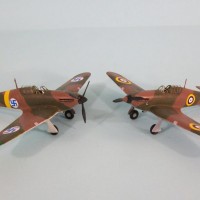Douglas SBD-2
This is the Academy boxing of the Accurate Miniatures kit. I bought it second-hand for my wife to give me for Christmas in 2018 and I couldn't wait to start it straight away. It only took me about three months elapsed time to finish, which is a record for me.
Academy provide three different schemes for this particular aircraft, representing different points in the aircraft's career.
- VB-2, January 1941: The first option is the original "yellow wings" scheme. It is quite colourful with a silver fuselage, a yellow tail and upper wings with red diagonal bands, a red upper front cowling and pale grey wing under surfaces.
Between this scheme and the next, the aircraft was painted overall light grey with standard sized, red centred national insignia in six positions. On the 7th of December, 1941, the aircraft was in a hangar, having been taken off the USS Lexington due to mechanical problems. In this guise, the aircraft sat out the attack on Pearl Harbor that brought the US into the now World War.
- VB-2, "Hit and Run" Raids, March 1942: The second option is post Pearl Harbor, when the aircraft had been painted blue-grey on upper surfaces with oversized national insignia on the wings and tail stripes. The aircraft re-joined USS Lexington and participated in attacks around New Guinea.
In April 1942 it was again at Pearl Harbor awaiting reassignment to a new unit as the USS Lexington sailed to her doom in the Battle of Coral Sea.
- VMSB-241, June 1942: The third option is a later scheme (May-June 1942), without the red centres to the resized national insignia in four locations and over-painted tail stripes, is from when the aircraft had been transferred to the Marine Scouting Squadron VMSB-241 and participated in the Battle of Midway. It was one of the few aircraft to return, albeit with around 250 bullet and shrapnel holes, from an unsuccessful attack on the Japanese carrier Hiryu. Its pilot Daniel Iverson and gunner Wallace Reid were awarded the Navy Cross and Distinguished Flying Cross respectively for the mission.
After Midway, the aircraft was repaired and served out the rest of the war as a carrier qualification training aircraft at NAS Glenview, Illinois, USA. It stalled and crashed into Lake Michigan on 11 June 1943 but was recovered in 1994 and, as noted above, is currently on display in the National Museum of Naval Aviation, NAS Pensacola.
I decided to model the aircraft as she appeared when she flew as part of VB-2 off the USS Lexington in 1942. At this time they flew attacks against the Japanese in and around New Guinea, which is the nearest neighbour to Australia. Besides that, I think the oversized national insignia look cool.
This aircraft was painted Non-Specular Light Grey 602 on the underside and Blue-Grey on the top surfaces. The kit instructions have the light grey as FS 36440 and the blue grey as FS 35189. I could get the Gunze Acrylic colour for the former (H325) from my local hobby shop, but not the latter (H367).
So, I went in search for an alternative paint. The true blue-grey colour is an elusive shade and best I could find searching the Internet is that it was a mixed shade, and therefore probably quite variable, and never received an official ANA number. However, I was building my F/A-18 at the same time and has just painted its upper surface FS 35237 Blue-Grey. I thought that this colour looked close to photos, particularly the aircraft itself at NAS Pensacola, so I used that colour on this kit.
Since I built the kit I've realised that the inside of the central dive flap should have been painted the Light Grey. Oh, well…
This is a fantastic kit and a quick and easy build.
I enjoyed it enormously.











Nicely done Michael, and it seems you had fun building her. But that's what this hobby is all about, enjoying the build and doing some research.
G'day Tom,
It was one of those rare builds where everything went smoothly and there was nothing that caused me to put it aside for a bit - that is until the very end when I attached, broke off, re-attached, broke off, re-attached... the dive flaps.
It took me back to when I built a pair of 1/72 Airfix SBDs (a -3 and -5 as I remember) when I was a teenager. I built one of those with gear up, dive flaps open and bomb trapeze extended and hung it from my bedroom ceiling in a steep dive.
Great build Michael, you gotta love these "Slow But Deadly's". I've wanted to do this particular plane in this getup for years. From here, and in my opinion, you hit the nail on the head with the color. Well done!
G'day Andrew,
Thanks. I remember looking at your own effort that you posted recently and thinking the same thing.
Looks great! Well done.
Thanks.
Great build of a great kit.
Thanks.
Looks very nice! Gotta love the Dauntless.
G'day Greg,
Thanks.
Yep, it is one of the icons of WWII and a lovely looking aircraft.
That’s beautiful!
Thanks.
An outstanding Dauntless! Well done.
Thanks
I really like the Dauntless and that looks like a fun kit. Funny thing is, I don't have any in my stash and have a moratorium on new kits for the stash. I will enjoy vicariously through nice builds like yours that I see on line. Thanks for sharing.
G'day Walt,
It was great fun.
The trick is, of course, to start the kit straight away so that it doesn't make it into the stash, just like I did.
Sweet build! The oversize roundels really look distinctive. Nice shading on the underside, too, really brought out the detail! Liked!